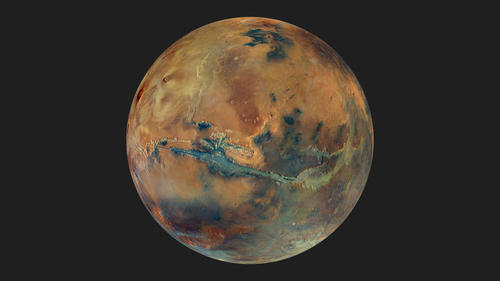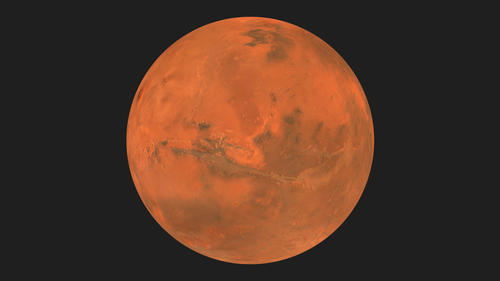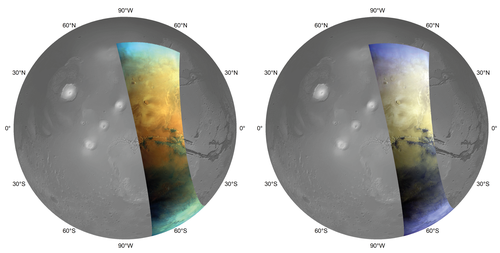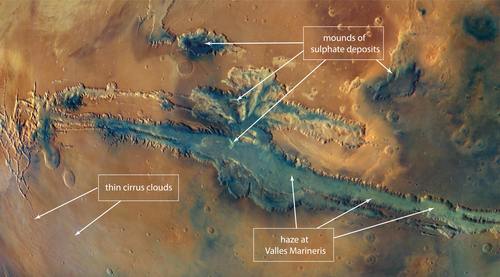Department of Earth Sciences
Service Navigation
Mars in color as never seen before
To mark the 20th anniversary of ESA's Mars Express spacecraft, the High Resolution Stereo Camera (HRSC) team is announcing the upcoming release of a global color mosaic of Mars that is unparalleled in its accuracy of color information and provides insight into the diverse composition of surface materials (images 1 and 2).
» read more in the main article below...
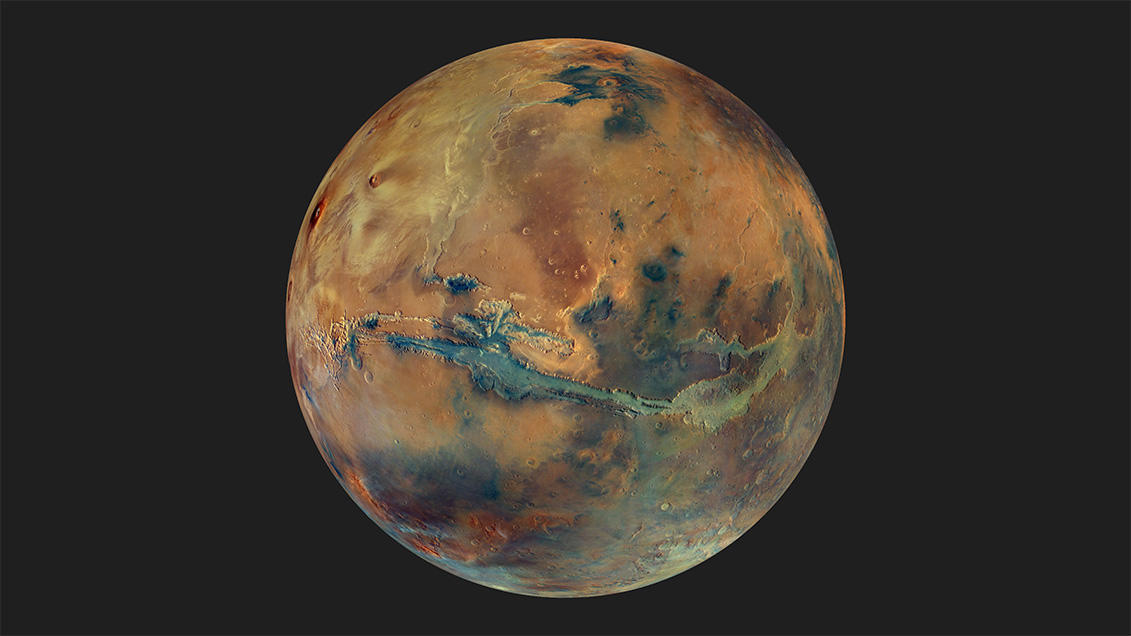
20 years HRSC on Mars Express • Images
Image 1
Simulated view of the HRSC colour mosaic from 2500 km above Valles Marineris, with locally enhanced colour: Composite of red, green, and blue filter mosaics, with the colour band values stretched individually.
Image Credit: ESA/DLR/FU Berlin/G. Michael
Image 2
Simulated view of the HRSC colour mosaic from 2500 km above Valles Marineris, natural colour: Composite of red, green, and blue filter mosaics, with the colour band values in their original proportion to one another. This is closer to what you might see, if you were flying over the surface of Mars.
Image Credit: ESA/DLR/FU Berlin/G. Michael
Image 3
Example of a single HRSC high-altitude image (HRSC orbit number 21,688_0000; Background MOLA shaded relief). Left: Red-green-blue-composite showing how the surface looks like in visible light. Note the light-blue colours of the northern and southern limb owing to a shallower view of the camera through the Martian atmosphere resulting in a stronger atmospheric influence of the images. Such image parts were excluded from the global mosaic. Right: Infrared-red-green-composite. Such unusual views including the infrared channel are one possible way to examine the relationship of the surface reflectivity in the infrared to that of other colours and have also been inspected to detect artefacts or holes in the input data.
Image Credit: ESA/DLR/FU Berlin/MOLA Science Team
Image 4
Closeup of the HRSC colour mosaic showing the canyon system Valles Marineris and annotated surface details: Sulphate deposits, haze/fog as well as thin cloud veneers. This tectonic graben stretches more than 4000 kilometers east-west and up to 700 kilometers north-south.
Image Credit: ESA/DLR/FU Berlin/G. Michael
Mars in color as never seen before
June 2, 2023 marks the 20th anniversary of the launch of the European space probe Mars Express. Mars Express is considered one of the most successful space missions ever sent to our neighboring planet. On board is the German "High Resolution Stereo Camera" (HRSC), which has been continuously recording images from Mars orbit ever since. The data stream from the HRSC has yielded a multitude of new insights in recent years. Gerhard Neukum (1944-2014) led the development of the HRSC, which is designed to perform global mapping of Mars at 12m resolution, providing simultaneously colour images of the surface and its topography. The HRSC was first installed on the Russian Mars 96 probe, which unfortunately failed to leave Earth's orbit after launch and burned up in the atmosphere. But Gerhard Neukum kept going, as director of the DLR Institute for Planetary Research in Berlin Adlershof, he became the key proponent for the first ESA research probe to be sent to another planet. In 2002, Gerhard Neukum moved to Freie Universität as a professor, where he established the Department of Planetary Sciences and Remote Sensing.
For its usual surface images, the HRSC normally photographs Mars from an altitude of about 300 kilometers, at about the point from which the elliptical orbit of the Mars Express satellite is closest to the planet. The resulting views of the Martian surface have a spatial resolution of up to 12.5 meters per pixel and cover areas about 50 kilometers wide. Thanks to its four colour channels (red, green, blue, infrared) and five panchromatic nadir, stereo, and photometric channels, the stereo camera can visualize Mars not only in three dimensions, but also in color.
For the global data product presented here, however, 90 individual images were used, taken from higher altitudes (roughly between 4000 and 10,000 km) above the Martian surface and thus covering areas around 2500 kilometers wide on average at lower spatial resolution (between 200 and 800 m/px) (image 3). Such large-scale images are typically obtained to observe weather patterns on Mars. If no clouds or other atmospheric phenomena are visible on the images, they are excellent for creating global views of the Martian surface.
The ever-changing transparency of the Martian atmosphere makes it difficult to determine accurate surface colours from orbit. Scattering and reflection of light off atmospheric dust causes colour shifts between images, making a mosaic of many together show a colour patchwork effect. Up until now, suppressing this effect has had the consequence of diminishing colour variations over distances greater than the scale of a single image. Here, we made use of a new high-altitude observation campaign to construct a global colour model, which was then used to colour-reference each image of the mosaic, enabling long range colour variations to be maintained and revealing a much richer colour view of the planet than has been seen before.
The global view of Mars shown here has a spatial resolution of 2 kilometers per pixel, although higher resolution data products are quite possible and are already in the works. This contrast-enhanced mosaic (image 1) reveals an unprecedented variety and detail of colors across the Martian surface, which at the same time provides information about its composition. It is well known that most of Mars is reddish in color, due to the high amount of oxidized iron in the dust on its surface, earning it the nickname "Red Planet." But it is also immediately noticeable that a not small part of Mars is rather dark, on image 1 bluish, colored. In fact, these are grayish-blackish sands, which are of volcanic origin and form far-reaching dark sand layers on Mars, but above all also were piled up by the wind to imposing sand dunes or enormous dune fields on the floor of impact craters. These unweathered sands consist of dark, basaltic minerals, of which also volcanic lava on earth is composed.
Material weathered under the influence of water, on the other hand, tends to take on lighter shades over time. For example, clay and sulfate minerals, the two most common water-weathered minerals on Mars, appear particularly bright on such color composites and are relatively easy to recognize on closer views. One of the largest clay mineral deposit on Mars around the former outflow channel Mawrth Vallis, is not shown in this view but has been observed by HRSC earlier and attest to a long-term existence of liquid water on Mars, with the original, basaltic source rock being altered at neutral pH and relatively warm temperatures weathered to clay minerals. Large occurrences of the likewise light-colored sulfate minerals can be seen in this view of Mars within the Valles Marineris canyon system (image 4). Here, they are covered by a thin veneer of dark sand and thus show their impressive colour variations only on closer look by HRSC. Sulphate minerals indicate less life-friendly environmental conditions at low pH values.
Faint, bright to light blue areas actually show clouds in the atmosphere (image 4), as images containing clouds could not be avoided so far in the creation of this first version of the global mosaic. The depths of Valles Marineris are also covered by atmospheric phenomena. However, these are fogs and hazes (image 4), which are particularly fond of forming in depressions at certain times of the day and year.
High Resolution Stereo Camera (HRSC)
The High Resolution Stereo Camera was developed at the German Aerospace Center (DLR) and built in collaboration with partners in industry (EADS Astrium, Lewicki Microelectronic GmbH and Jena-Optronik GmbH). The science team, which is headed by Principal Investigator (PI) Dr. Thomas Roatsch, consists of 52 co-investigators from 34 institutions and 11 countries. The camera is operated by the DLR Institute of Planetary Research in Berlin-Adlershof. The development of the colour model method and processing of the mosaic was performed by Dr. Greg Michael, who is part of the HRSC team at Freie Universität Berlin. The acquisition and planning of the high-altitude images were the responsibility of the camera operations team at the German Aerospace Center (DLR) at Berlin-Adlershof. On publication of the upcoming scientific paper on the mosaic, the georeferenced dataset will be made available through the ESA guest storage facility.
Images:
ESA/DLR/FU Berlin/G. Michael, CC BY-SA 3.0 IGO
Copyright Notice:
Where expressly stated, images are licenced under the Creative Commons Attribution-ShareAlike 3.0 IGO (CC BY-SA 3.0 IGO) licence. The user is allowed to reproduce, distribute, adapt, translate and publicly perform it, without explicit permission, provided that the content is accompanied by an acknowledgement that the source is credited as 'ESA/DLR/FU Berlin/G. Michael', a direct link to the licence text is provided and that it is clearly indicated if changes were made to the original content. Adaptation / translation / derivatives must be distributed under the same licence terms as this publication.
This work has been made possible through support from the German Space Agency (DLR Bonn) grant 50 OO 2204 (Koregistrierung) on behalf of the German Federal Ministry for Economic Affairs and Climate Action.

